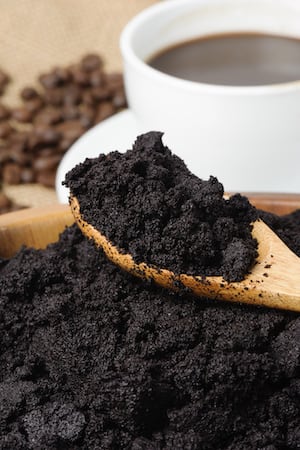Bonjour sweetpea's! (pardon the pun)

Today we are getting down to some serious homesteading/gardening prep, there's a lot to go over, important information you need, and I am including a great DIY garden fertilizer recipe, for all you intrepid homesteaders.
I am posting this because when I began my gardening & homesteading journey last year, on a whim really, there was a steep learning curve; and I thought, "Meh, what's the big deal?
I can totes do this, no problem!"
Believe me when I say, that was a dunderpaint move.
Turns out most of us city dwellers know squat about gardening, simple living, less consumption, and true homesteading.
R-E-A-L-LY????? You don't say?
Hey, most of us can order a mean Latté with a lovely chocolatine or snooty Earl Grey cup of tea easily enough, but ask us about dirt PH, seed starting times, and things like diatomaceous earth, we are pretty much out of our depth.
The great news is, it is NEVER too late to learn!
One of the first things I would highly recommend is getting some books, buy or borrow from your library but DO IT!!!! Seriously, the information I got was invaluable and it saved me time and money. Double win!
These were the one's I started with & I added Amazon links if you want to check them out:

https://www.amazon.ca/Indoor-Kitchen-Gardening-Year-round-Microgreens/dp/159186593X/ref=sr_1_1?s=books&ie=UTF8&qid=1490556607&sr=1-1&keywords=Indoor+kitchen+garden
![Herb Gardening: How to Prepare the Soil, Choose Your Plants, and Care For, Harvest, and Use Your Herbs (Countryman Know How) by [Snyder, Melissa Melton]](https://images-na.ssl-images-amazon.com/images/I/61I1xhCjkKL.jpg)
https://www.amazon.ca/Herb-Gardening-Prepare-Harvest-Countryman-ebook/dp/B010EB3BE6/ref=sr_1_1?s=books&ie=UTF8&qid=1490557182&sr=1-1&keywords=Herb+Gardening+by+Melissa+Melton

https://www.amazon.ca/Compost-City-Practical-Composting-Small-Space/dp/1611802202/ref=sr_1_1?s=books&ie=UTF8&qid=1490557863&sr=1-1&keywords=compost+city
This last one my Poppa Bear bought for me as a Christmas gift, which I got to choose! I like it a lot because it covers a vast array of topics in homesteading, which includes gardening, farm animals, bee keeping, growing and preserving food. It's a great book that has a simple layout and concise information for the budding,(pardon the pun) enthusiast.

https://www.amazon.ca/Good-Living-Guide-Country-Skills/dp/1680991221/ref=sr_1_2?s=books&ie=UTF8&qid=1490557632&sr=1-2&keywords=country+skills+by+Abigail+R.+Gehring
Second thing you need to do is get yourself a nice journal, it shall become you gardening journal, and YES, you need it. I started mine late and regretted it, the reason it's important is because you will need to reference it for things you have learned along the way; advice you have received, recipes you come across, and important discoveries and cool stuff that your fellow gardeners will share. Believe me, you will lose track and writing it down, along with drawing some cute pics in it will feel good. I enjoy reviewing what I wrote and will stick to it. I have noticed that Chef Jamie Oliver does it, along with many other gardeners I have spoken with, so I enthusiastically suggest it to you. I went and got a pretty and inexpensive journal from Peter Pauper Press, it looks exactly like this:
I have been using this companies journals for years, simply because they are very affordable, have beautiful covers, come with that wonderful elastic to hold my book and findings I stuff in, and my journal even has a cool little flap space to hold something special, like a pressed flower. I paid around $15 for it at Indigo book store. However, I am including the links to their website, so you can buy
directly:
http://www.peterpauper.com/
This is the link to the journal in pink above, it has foil colours that don't show well on here, and you can get it in different colours. Happy hunting!
http://www.peterpauper.com/product_info.php?products_id=5082&cPath=25_143
Third thing you need to do is figure out where you will be gardening, how much space you really have to work with, how is the lighting, shade, soil quality, are you allowed to plant there-ask your landlady or landlord before hand, if you rent? Also, take note of the animals that trundle through in your neighbourhood, yep, these will become pesky food thieves; and are very likely to cause damage to new growth seedlings, or dig viciously in your lovingly tended to pots. Man do they LOVE to dig! We have a lot of squirrels, cats, aggressive blue jays, and the night owl skunk family that makes the rounds. It has meant some losses the first year but now I know that nets and protective items are part of my to get list.
Fourth thing to do is sit down and make an achievable list of what you want to plant, what kind of garden and materials will be needed to achieve those goals, and budget it. I highly recommend starting with organic, heirloom, and local seeds, whenever possible. This is how you will be feeding you and yours, cutting food costs, saving the planet, and protecting your health can be made very easy; all you need do is start out right. I know it is a few dollars more but plant less, plan better, and reap, (literally) the rewards of doing it right from the start. This year I stopped at the health food store and they had organic and heirloom seeds out early, I bought:
-Rainbow chard mix
-Redventure celery (super excited about purplish celery!
-Mixed heirloom carrots
-Mixed lettuces
-Snap peas
-Parsley
-Parsley root
-A bunch of different herbs, including a gift of organic lemon balm seeds my PB got me but I seem to have misplaced recently. Hopefully I will find them soon. Sorry booboo.
I also was gifted a pack of scarlet runner beans, these one's are not organic but I will be using organic methods for growing. I thought it rude to look a gift seed in the mouth and was very happy to be given such a pretty bean seed. Yes, you will start to get excited about things you never even knew existed before. It's good, earthy, geeky fun-just go with it!
I am also hoping that my Black currant plant has survived and will come back/flourish this year.
We shall see.
I still have to get my hands on some pretty beets and radishes, as well as some Bok choy.
Here are some links to happy, organic, and heirloom seed places. The first one is in French, it's where my health food store gets their seeds here in Québec, apologies if you cannot understand it, mais bonne chance!
http://www.ecoumene.com/
This next one is well recommended, feel free to search the internet for the best sites with heirloom seeds/organic.
https://www.saltspringseeds.com/
I have also kept seeds from some seriously good batches of local tomatoes from last summer and some seeds from some cute little bebe organic tomatoes I have been eating. I figure, the seeds are there, why throw them when mother nature has given me the perfect way to recycle. It benefits my pocket book and puts less stress on the planet.
***Important tip***
I was told by Lady T last summer, when I was getting a bit down about not having accomplished all my gardening goals, something very important; and I quote, "With gardening, you will have the best of intentions but the reality is that what you think you can do and what you will end up being able to do, are two very different things. Learn to make peace with the season's of your garden, what time, weather, pests, soil difficulties, too dry or too wet summer days offer, and what life curve balls that will come between you and your best laid garden plans. Summer is a busy time, vacations come up, weddings and parties need attending, you work, people get injured or sick, time is not always yours, and then there is always Mother Nature to respect. And believe you me, she don't care about what you need. She's already taxed and overwhelmed with all the damage we are causing to her, be patient and kind. Gardening is a lifetime experience, and you should plan to approach it slow, small, and steadily.
Fifth thing that I suggest is starting a Pinterest gardening/homesteading board. There is a lot of knowledge floating around out there on the web, use it to advantage.
Sixth thing, please be extremely cautious about what products you use, what you plant, and the impact your pesticide choices are having. We are on the verge of losing bee colonies at an alarming rate, poisoning them and local wildlife is not an option. There are V-E-R-Y effective natural and organic alternatives that you can use. Don't go cheap and easy, go environmental, I give a crap, take the extra steps, and I do care approach. here's a list of bee friendly plants btw, you need to think about adding these in. Bumble bee's were placed on the endangered species list just recently, not good. Einstein warned us that if we lose the bee's-you know the food pollinators, our food collapses.
This IS important. No toxins, no Monsanto, bee Helpful, not harmful.

Lastly, get organic soil and make your own fertilizer, as well as making and using compost! I am including the recipe that I use for making my own liquid fertilizer, I got it from one of the above listed books, I believe it was the compost city but I may be mistaken. See why you need a garden journal? I will also be adding some seed starter charts-I am a bit late for a few but I was ill, injured my back, and started a new job. You will have to forgive the post delay.
There's pics to follow in the next blog posts of my own seedling adventure from last year and I am beginning this years batch next weekend! As this has already been a lot of info, I will get into real seed starting in an upcoming post. Enjoy.
ORGANIC CONCENTRATE LIQUID FERTILIZER RECIPE:
(not for ingesting,this is for PLANTS!)
6 Cups coffee grounds1-2 Cups used tea from tea bags5 Gallons of clear water4 Chopped,organic banana peels4 Cups chopped weeds/pruned foliage leaves1 Cup seaweed chopped1 Cup crushed organic egg shells (or regular, do what you can)1 Tbsp Molasses (feeds the good microbes)
Method:
-Place all in a bucket, stir well.
-Cover with cheesecloth and secure with an elastic
-Keep in a cool place and stir vigorously every day, for 3 days.
-Strain into another bucket, leave no big bits in liquid.
-Store in containers,I keep mine in the fridge and give a lot to friends and neighbours.
-To use*, 2 Cups liquid fertilizer concentrate in 1 Gallon of water for a small garden. Double and triple depending on the size of your garden. Medium size 4 Cups to two gallons water, 6 Cups to 3 Gallons for larger, and soon.
-Use weekly in your garden and watch it flourish!
*Please note that this is a concentrated fertilizer, you need to dilute it in water or it can harm your plants.

For more info on fertilizer ingredients and options check here:
https://www.homegrownfun.com/natural-fertilizers-around-house/



Take care, be well, love freely. God bless!




























This comment has been removed by the author.
ReplyDeleteMaybe I'll get to pick out one of my gifts this year Country Skills? LoL #woohoo
ReplyDelete